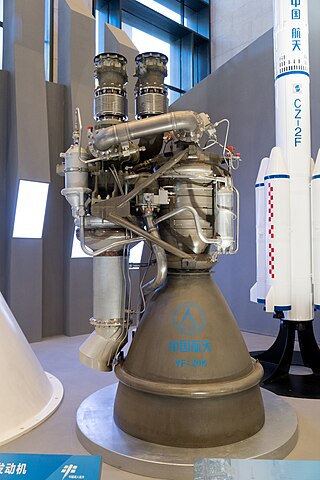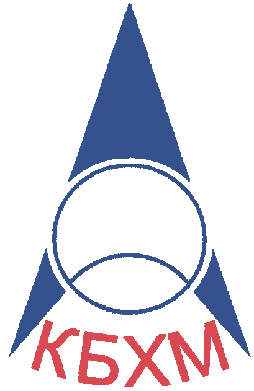| Country of origin | USSR |
|---|---|
| First flight | 1981-12-27 [1] |
| Designer | OKB-154 [1] |
| Associated LV | RSM-54, Shtil' [1] |
| Status | Retired |
| Liquid-fuel engine | |
| Propellant | N2O4 [1] / UDMH [1] |
| Mixture ratio | 2.6 [2] |
| Cycle | Oxidizer Rich Staged combustion [1] |
| Configuration | |
| Chamber | 1 [2] |
| Performance | |
| Thrust | 682 kilonewtons (153,000 lbf) [2] |
| Chamber pressure | 27.5 megapascals (3,990 psi) [2] |
| Specific impulse, vacuum | 310 s (3.0 km/s) [2] |
| Specific impulse, sea-level | 280 s (2.7 km/s) [2] |
| Burn time | 74 seconds [2] |
| Used in | |
| RD-0243 Propulsion Module [3] | |
| Country of origin | USSR |
|---|---|
| First flight | 1981-12-27 [1] |
| Designer | OKB-154 [1] |
| Associated LV | RSM-54, Shtil' [1] |
| Status | Retired |
| Liquid-fuel engine | |
| Propellant | N2O4 [1] / UDMH [1] |
| Mixture ratio | 2.6 [4] |
| Cycle | Gas Generator [1] |
| Configuration | |
| Chamber | 4 [4] |
| Nozzle ratio | 14 |
| Performance | |
| Thrust | 211 kilonewtons (47,000 lbf) [4] |
| Chamber pressure | 14.7 megapascals (2,130 psi) [4] |
| Specific impulse, vacuum | 300 s (2.9 km/s) [4] |
| Specific impulse, sea-level | 280 s (2.7 km/s) [4] |
| Burn time | 79 seconds [4] |
| Used in | |
| RD-0243 Propulsion Module [3] | |
The RD-0243 (Russian : Ракетный Двигатель-0243, romanized: Raketnyy Dvigatel-0243, lit. 'Rocket Engine 0243') is a propulsion module composed of an RD-0244 main engine and a RD-0245 vernier thruster. Both are liquid-fuel rocket engines, burning a hypergolic mixture of unsymmetrical dimethylhydrazine (UDMH) fuel with dinitrogen tetroxide (N2O4) oxidizer. The RD-0244 main engine operates in the oxidizer rich staged combustion cycle, while the vernier RD-0245 uses the simpler gas generator cycle. Since volume is at a premium on submarine launches, this module is submerged on the propellant tank. [3] Its development period was from 1977 to 1985, having had its first launch on December 27, 1981. Originally developed for the RSM-54, it was used later for the Shtil'. [1]

The RD-58 is a rocket engine, developed in the 1960s by OKB-1, now RKK Energia. The project was managed by Mikhail Melnikov, and it was based on the previous S1.5400 which was the first staged combustion engine in the world. The engine was initially created to power the Block D stage of the Soviet Union's abortive N1 rocket. Derivatives of this stage are now used as upper stages on some Proton and Zenit rockets. An alternative version of the RD-58 chamber, featuring a shorter nozzle, was used as the N1's roll-control engine.

The AJ10 is a hypergolic rocket engine manufactured by Aerojet Rocketdyne. It has been used to propel the upper stages of several launch vehicles, including the Delta II and Titan III. Variants were and are used as the service propulsion engine for the Apollo command and service module, in the Space Shuttle Orbital Maneuvering System, and on the European Service Module – part of NASA's Orion spacecraft.

The RD-253 and its later variants, the RD-275 and RD-275M, are liquid-propellant rocket engines developed in the Soviet Union by Energomash. The engines are used on the first stage of the Proton launch vehicle and use an oxidizer-rich staged combustion cycle to power the turbopumps. The engine burns a hypergolic mixture of unsymmetrical dimethylhydrazine (UDMH) fuel with dinitrogen tetroxide oxidizer, which are highly toxic, but storable at room temperature.
The RD-843 is a Ukrainian single nozzle liquid propellant rocket engine. It burns a hypergolic mixture of unsymmetrical dimethylhydrazine (UDMH) fuel with dinitrogen tetroxide (N2O4) oxidizer. It is pressure-fed. It is rated for up to 5 restarts, and can gimbal up to 10 degrees in each direction.
The RD-0214 (Russian: Ракетный Двигатель-0214 [РД-0214], romanized: Raketnyy Dvigatel-0214, lit. 'Rocket Engine 0214', GRAU index: 8D811) is a vernier thruster rocket engine burning unsymmetrical dimethylhydrazine (UDMH) fuel with dinitrogen tetroxide (N2O4) oxidizer in a gas-generator cycle. It has four nozzles that can each gimbal 45 degrees in plane to provide thrust vectoring control to the RD-0212 propulsion module of Proton rocket's third stage. It is a revised version of the RD-0207 (Russian: РД-0214, GRAU index: 8D67).

The RD-0210 (Russian: Ракетный Двигатель-0210, romanized: Raketnyy Dvigatel-0210, lit. 'Rocket Engine 0210', GRAU index: 8D411K) is also known as the RD-465. It and its twin, the RD-0211, are rocket engines using unsymmetrical dimethylhydrazine (UDMH) as fuel and dinitrogen tetroxide (N2O4) as oxidizer in an oxidizer rich staged combustion cycle. They have a single nozzle, possess thrust vectoring and are the latest evolution in the RD-0203/4 lineage. They are the engines used on the Proton second stage. The RD-0213 is a fixed nozzle variation that is used on the RD-0212 module of the Proton third stage.
The RD-0216 (Russian: Ракетный Двигатель-0216, romanized: Raketnyy Dvigatel-0216, lit. 'Rocket Engine 0216') and RD-0217 are liquid rocket engines, burning N2O4 and UDMH in the oxidizer rich staged combustion cycle. The only difference between the RD-0216 and the RD-0217 is that the latter doesn't have a heat exchanger to heat the pressuring gasses for the tanks. Three RD-0216 and one RD-0217 were used on the first stage of the UR-100 ICBM. The engines were manufactured until 1974 and stayed in operational use until 1991. More than 1100 engines were produced.
The RD-0233 and RD-0234 are liquid-fueled rocket engines which burn a hypergolic mixture of unsymmetrical dimethylhydrazine (UDMH) fuel with dinitrogen tetroxide oxidizer in an oxidizer-rich staged combustion cycle. The only difference between the RD-0233 and the RD-0234 is that the latter has a heat exchanger to heat the pressuring gasses for the tanks. Three RD-0233 and one RD-0234 are used on the first stage of the UR-100UTTKh ICBM. While the engine is out of production, the ICBM as well as Rokot and Strela remain operational as of 2015.
The RD-0236 is a vernier thruster engine for liquid-fueled rockets. It burns a hypergolic mixture of unsymmetrical dimethylhydrazine (UDMH) fuel with dinitrogen tetroxide oxidizer in a gas generator cycle. It is used along the RD-0235 main engine on the UTTKh second stage, which was featured in the UR-100N ICBM as well as the Strela and Rokot launch vehicles derived from it. Its function is to supply thrust vector control by gimbaling each of its four nozzles in a plane. While the engine is out of production, the ICBM as well as Strela remain operational as of 2015. The Rokot launch vehicle conducted its final launch before retirement in December 2019.
The RD-0237 is a vernier thruster engine used on liquid-fueled rockets burning a hypergolic mixture of unsymmetrical dimethylhydrazine (UDMH) fuel with dinitrogen tetroxide oxidizer, pressure-fed to the engine. It is used on the UR-100UTTKh MIRV vehicle to supply thrust vector control by gimbaling of its nozzle. While the engine is out of production, the ICBM and Strela remain operational as of 2015.
The RD-263 is a liquid-fuel rocket engine, burning a hypergolic mixture of unsymmetrical dimethylhydrazine (UDMH) fuel with dinitrogen tetroxide oxidizer in the oxidizer rich staged combustion cycle. Four RD-263 engines form a propulsion module RD-264. For the R-36M KB Yuzhnoye only ordered the first stage propulsion to Energomash, instead of both stages, arguing that they were overworked with the RD-270 development. By April 1970 Yuzhnoye was getting the engine documentation. By the end of 1972 Energomash started to test fire the engines in its own test stand. And by September 1973 the engine was certified for flight. While the engine is out of production, the ICBM as well as the Dnepr remain operational as of 2015.

The RD-119 was a liquid rocket engine, burning liquid oxygen and UDMH in the gas-generator cycle. It has a huge expansion ratio on the nozzle and uses a unique propellant combination to achieve an extremely high isp of 352 s for a semi-cryogenic gas-generator engine. It also has a unique steering mechanism. The engine main nozzle is fixed, and the output of the gas generator is fed into four nozzles on the side of the engine. Instead of using gimbaled verniers to supply vector control, the combustion gases are distributed by an electrically driven system that can control the thrust among the nozzles.

The YF-20 is a Chinese liquid-fuel rocket engine burning N2O4 and UDMH in a gas generator cycle. It is a basic engine which when mounted in a four engine module forms the YF-21. The high altitude variation is known as the YF-22 is normally paired with the YF-23 vernier to form the YF-24 propulsion module for second stages. New versions when used individually for booster applications are called YF-25.
The YF-23 is a liquid rocket vernier engine, burning N2O4 and UDMH. It is used in along the YF-22 to form the YF-24 and YF-25 propulsion modules.

The A.M. Isayev Chemical Engineering Design Bureau, also known as KB KhimMash or just KBKhM, is a Russian rocket engine design and manufacturing company. It is located in the city of Korolyov. It started as the OKB-2 division of the NII-88 research institute, where A.Isaev directed the development of liquid rocket engines for ballistic missile submarines.

The RD-250 is the base version of a dual-nozzle family of liquid-fuel rocket engines, burning a hypergolic mixture of unsymmetrical dimethylhydrazine (UDMH) fuel with dinitrogen tetroxide oxidizer in an gas-generator open cycle. The RD-250 was developed by OKB-456 for Yangel's PA Yuzhmash ICBM, the R-36 (8K67). Its variations were also used on the Tsyklon-2 and Tsyklon-3 launch vehicles. It was supposed to be used on the Tsyklon-4, but since the cancellation of the project it should be considered as out of production.

The RD-215 was a dual nozzle liquid-fuel rocket engine, burning a hypergolic mixture of unsymmetrical dimethylhydrazine (UDMH) fuel with AK-27 oxidizer. It was used in a module of two engines known as the RD-216. The RD-215 was developed by OKB-456 for Yangel's Yuzhmash R-14 (8K65) ballistic missile. Its variations were also used on the Kosmos-1, Kosmos-3 and Kosmos-3M launch vehicles.
The RD-861 is a Soviet liquid propellant rocket engine burning a hypergolic mixture of unsymmetrical dimethylhydrazine (UDMH) fuel with dinitrogen tetroxide oxidizer in a gas generator combustion cycle. It has a main combustion chamber, with four vernier nozzles fed by the gas generator output. It can be reignited a single time.
The RD-856, also known as the RD-69M, is a four-nozzle liquid-fuel rocket vernier engine, burning a hypergolic mixture of unsymmetrical dimethylhydrazine (UDMH) fuel with dinitrogen tetroxide oxidizer in a gas generator cycle. It was used on the R-36, Tsyklon-2 and Tsyklon-3 second stage as thrust vector control by gimbaling of its nozzle. The engine is distributed through a cylindrical structure that is integrated around the main engine RD-252 module. The structure includes aerodynamic protection for the nozzles. The engine was started by a pyrotechnic ignitor.
The RD-0255 is a propulsion module composed of an RD-0256 main engine and a RD-0257 Vernier thruster. Both are liquid-fuel rocket engines, burning a hypergolic mixture of unsymmetrical dimethylhydrazine (UDMH) fuel with dinitrogen tetroxide oxidizer. The RD-0256 main engine operates in the oxidizer rich staged combustion cycle, while the vernier RD-0257 uses the simpler gas generator cycle. It was used on the R-36MUTTKh (GRAU:15A18) and R-36M2 (GRAU:15A18M). Subsequently, it has been in the Dnepr second stage and as of 2016 it is still in active service.